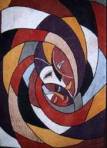
The Obom, in Fang-Beti (Cameroon) language, means tissue of the bark of the Aloa tree. The bark of the “aloa” tree – a widespread tree in the equatorial forest, particularly originating from Cameroon my home country, – was used in former times for the manufacture of loincloths. The Aloa tree has a fibery bark, and is a soft white wood; it grows quite fast, and once at maturity, its flowers drop seeds which grow around the tree. This natural fibre is obtained in Cameroon in traditional ways. The bark layers which have a thickness of 1 to 2 mm, are treated as intact sheets with water steam and are subsequently softened by beating. The full description on how the Obom is extracted can be read in full from the webpage of Etolo Eyah, a Cameroonian artist master of Obom.

The originality, beauty, and genuineness of the obom bark in combination with modern fabric and leather confers to any creations a touch of exclusivity, in a very ‘green’ manner, leading to sustainable development and handicraft.

The obom enjoys the reputation of being a material of great value and is therefore often also used as canvas for paintings, in witness of the riches of their owners; there are several Cameroonian painters who particularly use the Obom as canvas. This natural fibre can be machine washable and ironed. The use of the obom bark in modern couture is unique. I can testify of this because I have a hat made up of Obom which I have had for over 12 years! Please check out the websites of several stylists and painters, such as Martial Tapolo, Cornelia Orsucci, Peter Musa, Otheo, and Arlette Dorothee Efang, to name just a few. The video below just shows the processus of harvesting and cleaning the tree bark; the bark shown is not obom!


très bon article, merci pour les détails.
j’ai eu l’occassion de rencontrer l’artiste Arlette EFANG et j’ai trouvé qu’elle pouvait à travers ses tableaux donner une seconde vie à cet écorce d’arbre. j’ai été surprise car je n’aurais jamais imaginé qu’un arbre puisse donner une toile aussi solide et être utiliser de la sorte. Bravo Cameroun et à tous ses artistes.
LikeLike
salut ss sa fille j’apprecie ce ke mon papa fais é kil contunu de lavant
LikeLike
Salut, j’essaie sans grand succes de joindre maitre Etolo au travers du contact telephonique laisse sur son web page. Peut etre sa fille pourrait-elle me renseigner?
Thank you.
LikeLike
Pingback: The Baobab: Symbol of Power, Presence, Strength, and Grace « African Heritage
Pingback: History of African Fabrics and Textiles | African Heritage
Pingback: The History of African Prints | Simply Felicia
Pingback: History Of African Fabrics And Textiles - Uncensored Opinion
Pingback: Colourful Designed fabrics for Clothing - Best News And Entertainment Website